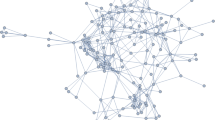Abstract
In this study, new centrality (collaborative) measures are proposed for a node in weighted networks in three different categories. The bibliometric indicators’ concepts (e.g., h-index and g-index) are applied to the network analysis measures in order to introduce the new centrality measures. First category of measures (i.e., l-index, al-index and gl-index) only considers a node’s neighbors’ degree. Second category of measures (i.e., h-Degree, a-Degree and g-Degree) takes into account the links’ weights of a node in a weighted network. Third category of measures (i.e., Hw-Degree, Aw-Degree and Gw-Degree) combines both neighbors’ degree and their links’ weight. Using a co-authorship network, the association between these new measures and the existing measures with scholars’ performance is examined to show the applicability of the new centrality measures. The analysis shows that the scholars’ citation-based performances measures are significantly associated with all the proposed centrality measures but the correlation coefficient for the ones based on average indicators (i.e., a-Degree and Aw-Degree) is the highest.

Similar content being viewed by others
References
Abbasi, A., & Altmann, J. (2010). A asocial network system for analyzing publication activities of researchers. In T. J. Bastiaens, U. Baumol, & B. J. Kramer (Eds.), On collective intelligence (Vol. 76, pp. 49–61). Berlin: Springer.
Abbasi, A., & Hossain, L. (2013). Hybrid centrality measures for binary and weighted networks. In R. Menezes, A. Evsukoff, & M. C. González (Eds.), Complex networks (Studies in computational intelligence) (Vol. 424, pp. 1–7). Berlin: Springer.
Abbasi, A., Altmann, J., & Hwang, J. (2010). Evaluating scholars based on their academic collaboration activities: Two indices, the rc-index and the cc-index, for quantifying collaboration activities of researchers and scientific communities. Scientometrics, 83(1), 1–13.
Abbasi, A., Altmann, J., & Hossain, L. (2011). Identifying the effects of co-authorship networks on the performance of scholars: A correlation and regression analysis of performance measures and social network analysis measures. Journal of Informetrics, 5(4), 594–607.
Abbasi, A., Chung, K. S. K., & Hossain, L. (2012a). Egocentric analysis of co-authorship network structure, position and performance. Information Processing and Management, 48(4), 671–679.
Abbasi, A., Hossain, L., & Leydesdorff, L. (2012b). Betweenness centrality as a driver of preferential attachment in the evolution of research collaboration networks. Journal of Informetrics, 6(1), 403–412.
Brandes, U., & Fleischer, D. (2005) Centrality measures based on current flow. In V. Diekert, & B. Durand (Eds.), STACS’05 Proceedings of the 22nd annual conference on theoretical aspects of computer science (pp. 533–544). Berlin: Springer.
Dierickx, I., & Cool, K. (1989). Asset stock accumulation and sustainability of competitive advantage. Management Science, 35(12), 1504–1511.
Egghe, L. (2006). Theory and practise of the g-index. Scientometrics, 69(1), 131–152.
Jin, B. (2006). H-index: an evaluation indicator proposed by scientist. Science Focus, 1(1), 8–9.
Korn, A., Schubert, A., & Telcs, A. (2009). Lobby index in networks. Physica A: Statistical Mechanics and its Applications, 388(11), 2221–2226.
Oh, W., Choi, J. N., & Kim, K. (2006). Coauthorship dynamics and knowledge capital: the patterns of cross-disciplinary collaboration in information systems research. Journal of Management Information Systems, 22(3), 266–292.
Schubert, A. (2012). A hirsch-type index of co-author partnership ability. Scientometrics, 91(1), 303–308.
Takeda, H., Truex III, D., & Cuellar, M. (2010). Evaluating scholarly influence through social network analysis: The next step in evaluating scholarly influence. AMCIS 2010 Proceedings, 573.
Wasserman, S., & Faust, K. (1994). Social network analysis: Methods and applications. Cambridge: Cambridge University Press.
Yan, E., & Ding, Y. (2009). Applying centrality measures to impact analysis: A coauthorship network analysis. Journal of the American Society for Information Science and Technology, 60(10), 2107–2118.
Yana, X., Zhaia, L., & Fan, W. (2013). C-index: A weighted network node centrality measure for collaboration competence. Journal of Informetrics, 7(1), 223–239.
Zhao, S. X., Rousseau, R., & Ye, F. Y. (2011). H-degree as a basic measure in weighted networks. Journal of Informetrics, 5(4), 668–677.
Zhuge, H., & Zhang, J. (2010). Topological centrality and its e-science applications. Journal of the American Society for Information Science and Technology, 61(9), 1824–1841.
Acknowledgments
Author appreciates the anonymous reviewers for the constructive and invaluable comments on earlier versions of this manuscript.
Author information
Authors and Affiliations
Corresponding author
Rights and permissions
About this article
Cite this article
Abbasi, A. h-Type hybrid centrality measures for weighted networks. Scientometrics 96, 633–640 (2013). https://doi.org/10.1007/s11192-013-0959-y
Received:
Published:
Issue Date:
DOI: https://doi.org/10.1007/s11192-013-0959-y




